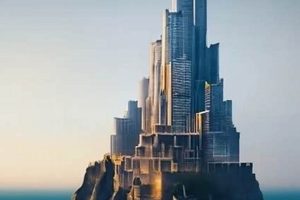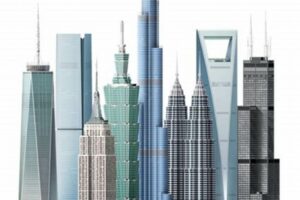Hong Kong skyscrapers are a prominent feature of the city’s skyline, with their towering heights and unique designs. These buildings serve various purposes, including residential, commercial, and retail.
The construction of skyscrapers in Hong Kong began in the early 20th century, and the city has since become known for its impressive skyline. Some of the most iconic skyscrapers in Hong Kong include the International Commerce Centre, the Two International Finance Centre, and the Central Plaza. These buildings are not only architectural marvels but also important landmarks in the city.
Skyscrapers play a significant role in Hong Kong’s economy, providing office space for businesses and housing for residents. They also contribute to the city’s tourism industry, with many visitors coming to Hong Kong to admire the city’s skyline. The construction of skyscrapers in Hong Kong is expected to continue in the future, with several new developments planned for the coming years.
1. Tall
Hong Kong skyscrapers are renowned for their exceptional height, which is a defining characteristic of these architectural marvels. The pursuit of constructing ever-taller buildings in Hong Kong is driven by several factors. One key reason is the city’s limited land area. With a population of over 7 million people in a relatively small geographical area, building upwards has become a necessity to accommodate the growing population and business needs.
- Height and Urban Planning
The construction of tall skyscrapers allows for efficient use of land, enabling the city to accommodate a large population and businesses within a compact urban environment. This vertical development strategy helps preserve valuable land for other purposes, such as parks, green spaces, and essential infrastructure.
- Economic Advantages
Tall skyscrapers offer significant economic benefits. They provide ample space for offices, retail, and residential units, catering to the demands of a growing economy. The rental and sale of these spaces generate substantial revenue, contributing to the city’s economic prosperity.
- Engineering Innovations
The construction of tall skyscrapers in Hong Kong has pushed the boundaries of engineering and architectural design. Engineers and architects have developed innovative solutions to overcome challenges related to wind resistance, structural stability, and efficient use of space. These advancements have led to the creation of iconic and structurally sound skyscrapers that are admired worldwide.
- Global Recognition
Hong Kong’s tall skyscrapers have garnered international recognition, contributing to the city’s reputation as a global financial and business hub. The impressive skylines, featuring these architectural wonders, have become synonymous with Hong Kong’s economic success and its position as a major player in the international arena.
In conclusion, the height of Hong Kong skyscrapers is not merely an aesthetic feature but a strategic response to the city’s unique circumstances and a testament to its economic vitality and engineering prowess. These tall buildings play a crucial role in accommodating the city’s population and businesses, contributing to its economic prosperity, and showcasing its architectural achievements on a global scale.
2. Unique
Hong Kong skyscrapers are renowned for their exceptional height, which is a defining characteristic of these architectural marvels. However, beyond their height, Hong Kong skyscrapers are also unique in several other aspects, showcasing a blend of innovative design, cultural influences, and sustainable practices.
- Architectural Innovation
Hong Kong skyscrapers are a testament to architectural innovation and cutting-edge design. Architects have pushed the boundaries of structural engineering to create buildings with unique shapes, forms, and facades. These skyscrapers often incorporate sky gardens, rooftop terraces, and other green features, blurring the lines between the built environment and nature.
- Cultural Influences
Hong Kong’s unique cultural heritage is reflected in the design of its skyscrapers. Many buildings incorporate traditional Chinese architectural elements, such as curved roofs, intricate latticework, and auspicious symbols. This blend of modern and traditional aesthetics creates a harmonious and visually stunning urban landscape.
- Sustainable Design
Hong Kong skyscrapers are increasingly incorporating sustainable design principles to reduce their environmental impact. Green roofs, rainwater harvesting systems, and energy-efficient lighting are common features in many new developments. These buildings aim to minimize their carbon footprint and contribute to the city’s overall sustainability goals.
- Mixed-Use Development
Many Hong Kong skyscrapers are mixed-use developments, combining residential, commercial, and retail spaces within a single building. This integrated approach creates vibrant and self-sufficient urban environments where people can live, work, and shop in close proximity. Mixed-use developments promote walkability and reduce the need for car travel.
In conclusion, the uniqueness of Hong Kong skyscrapers lies in their blend of architectural innovation, cultural influences, sustainable design, and mixed-use development. These buildings are not only iconic landmarks but also reflections of Hong Kong’s vibrant culture and commitment to progress and sustainability.
3. Impressive
Hong Kong’s skyscrapers are widely recognized for their impressive nature, which encompasses various aspects of their design, construction, and impact on the city’s skyline and urban environment.
- Architectural Marvels
Hong Kong’s skyscrapers are architectural marvels that showcase innovative design and engineering prowess. Their unique shapes, intricate facades, and soaring heights make them iconic landmarks that define the city’s skyline. These buildings often incorporate advanced construction techniques and materials, pushing the boundaries of architectural design.
- Engineering Excellence
The construction of Hong Kong’s skyscrapers is a testament to engineering excellence. Engineers have overcome significant challenges, such as limited land area and seismic activity, to create structurally sound and resilient buildings. These skyscrapers employ advanced engineering solutions, such as high-strength concrete, innovative structural systems, and wind-resistant designs, e
nsuring their stability and safety. - Vertical Cities
Hong Kong’s skyscrapers are often referred to as “vertical cities” as they combine various functions within a single structure. These buildings house offices, residential units, retail spaces, and public amenities, creating self-contained urban environments where people can live, work, and enjoy leisure activities without leaving the building. This mixed-use approach promotes sustainability and reduces the need for urban sprawl.
- Economic Powerhouses
Hong Kong’s skyscrapers are economic powerhouses that contribute significantly to the city’s financial success. These buildings provide prime office space for businesses and corporations, attracting domestic and international investment. The rental and sale of these spaces generate substantial revenue, contributing to the city’s economic growth and prosperity.
In conclusion, Hong Kong’s skyscrapers are impressive not only for their physical attributes but also for their engineering excellence, their role as vertical cities, and their contribution to the city’s economic success. These impressive structures are symbols of Hong Kong’s modernity, ambition, and global significance.
4. Residential
Residential skyscrapers are a prominent feature of Hong Kong’s skyline, providing housing for a significant portion of the city’s population. These buildings offer a range of living options, from luxury apartments to affordable housing, catering to the diverse needs of Hong Kong’s residents.
- High-Rise Living
Hong Kong’s residential skyscrapers are known for their height, with many reaching over 50 stories. This vertical living concept allows for efficient use of land and provides stunning views of the city and its surroundings. High-rise residential buildings often feature amenities such as swimming pools, fitness centers, and rooftop gardens, offering a comfortable and convenient living experience.
- Mixed-Use Developments
Many residential skyscrapers in Hong Kong are part of mixed-use developments, which combine residential units with commercial and retail spaces. This integrated approach creates vibrant and self-sufficient urban environments where residents can live, work, and shop without leaving the building complex. Mixed-use developments promote walkability and reduce the need for car travel.
- Affordable Housing
To address the need for affordable housing, the Hong Kong government has implemented various schemes to provide subsidized housing for low-income families. These subsidized housing units are often located in residential skyscrapers, ensuring that even those with limited financial means have access to quality housing in convenient locations.
- Luxury Living
Hong Kong’s residential skyscrapers also cater to the luxury market, offering high-end apartments with exclusive amenities and services. These luxury apartments are often located in prime areas of the city and provide residents with access to the finest dining, shopping, and entertainment options. The demand for luxury apartments in Hong Kong remains strong, attracting both local and international buyers.
In conclusion, residential skyscrapers play a vital role in Hong Kong’s urban landscape, providing a range of housing options for the city’s diverse population. From high-rise living and mixed-use developments to affordable housing and luxury apartments, these buildings cater to the varying needs and aspirations of Hong Kong’s residents.
5. Commercial
Commercial skyscrapers are a prominent feature of Hong Kong’s skyline, housing businesses, corporations, and financial institutions. These buildings play a crucial role in the city’s economy and contribute to its status as a global financial center.
- Office Space
Commercial skyscrapers provide prime office space for businesses of all sizes, from startups to multinational corporations. These offices offer modern amenities, advanced technology, and convenient access to transportation hubs, making them highly desirable for businesses seeking a prestigious and efficient work environment.
- Retail Hubs
Many commercial skyscrapers in Hong Kong incorporate retail spaces on their lower floors, creating vibrant shopping destinations. These retail hubs offer a wide range of goods and services, from luxury boutiques to everyday necessities, catering to the needs of both local residents and tourists.
- Economic Drivers
Commercial skyscrapers are significant economic drivers for Hong Kong. The rental and sale of office and retail spaces generate substantial revenue, contributing to the city’s GDP. Additionally, these buildings attract foreign investment and support the growth of various industries, including finance, technology, and tourism.
- Architectural Landmarks
Hong Kong’s commercial skyscrapers are not only functional but also architectural landmarks that define the city’s skyline. These buildings showcase innovative designs, incorporate sustainable features, and often feature iconic structures that have become synonymous with Hong Kong’s identity.
In conclusion, commercial skyscrapers are an integral part of Hong Kong’s urban landscape, serving as hubs for business, commerce, and economic growth. These buildings not only provide essential infrastructure for the city’s economy but also contribute to its architectural heritage and global recognition.
6. Retail
Retail plays a significant role in Hong Kong skyscrapers, contributing to their economic vitality and urban appeal. These buildings often incorporate retail spaces on their lower floors, creating vibrant shopping destinations that cater to the needs of both local residents and tourists.
- Shopping Hubs within Skyscrapers
Hong Kong skyscrapers offer a unique shopping experience, with retail spaces seamlessly integrated into the building’s design. These retail hubs feature a wide range of shops, from luxury boutiques to everyday necessities, offering convenience and variety to shoppers.
- Mixed-Use Developments
Many commercial skyscrapers in Hong Kong are part of mixed-use developments, which combine residential, office, and retail spaces within a single building. This integrated approach creates self-sufficient urban environments where people can live, work, and shop without leaving the building complex.
- Economic Impact
The retail spaces in Hong Kong skyscrapers contribute significantly to the city’s economy. The rental and sale of these spaces generate substantial revenue, supporting businesses and creating employment opportunities. Additionally, retail activities attract tourists and boost the city’s tourism industry.
- Architectural Considerations
The incorporation of retail spaces in skyscrapers requires careful architectural planning. Designers must ensure that these spaces are accessible, well-lit, and visually appealing to attract sho
ppers and enhance the overall experience of the building.
In conclusion, the connection between retail and Hong Kong skyscrapers is mutually beneficial. Retail spaces add vibrancy and economic value to skyscrapers, while skyscrapers provide a prestigious and convenient location for businesses to operate and thrive.
7. Economic
Hong Kong skyscrapers are deeply intertwined with the city’s economic landscape, playing a pivotal role in its financial success and global standing. These towering structures serve as hubs for businesses, corporations, and financial institutions, contributing significantly to Hong Kong’s reputation as a leading financial center.
- Office Space
Commercial skyscrapers provide prime office space for businesses of all sizes, from startups to multinational corporations. These offices offer modern amenities, advanced technology, and convenient access to transportation hubs, making them highly desirable for businesses seeking a prestigious and efficient work environment. The presence of numerous businesses within skyscrapers creates a concentrated hub of economic activity, fostering collaboration and innovation.
- Financial Hub
Hong Kong is renowned for its robust financial sector, and skyscrapers play a central role in this industry. Many skyscrapers house banks, investment firms, and other financial institutions, creating a vibrant financial ecosystem. The close proximity of these institutions facilitates networking, deal-making, and the exchange of financial expertise, contributing to Hong Kong’s position as a global financial hub.
- Tourism and Hospitality
Hong Kong’s skyscrapers are not just business centers; they also cater to the tourism industry. Many skyscrapers incorporate retail spaces, restaurants, and hotels, offering visitors a unique shopping, dining, and accommodation experience. The iconic architecture and stunning views from these skyscrapers make them popular tourist destinations, generating revenue and supporting the city’s hospitality sector.
- Economic Growth and Investment
The construction and maintenance of skyscrapers involve substantial investment, both from the private and public sectors. This investment stimulates economic growth by creating jobs in various industries, including construction, design, and property management. Additionally, skyscrapers attract foreign investment, as businesses and investors seek to establish a presence in Hong Kong’s thriving economy and prestigious skyline.
In conclusion, the economic significance of Hong Kong skyscrapers is multifaceted. These structures provide essential office space for businesses, foster a thriving financial industry, contribute to tourism and hospitality, and stimulate economic growth and investment. Their presence has solidified Hong Kong’s position as a global economic powerhouse and a sought-after destination for businesses and investors.
8. Tourism
Hong Kong skyscrapers are not just architectural marvels; they also play a significant role in attracting tourists from around the world. These towering structures offer unique experiences and breathtaking views, making them popular destinations for leisure and business travelers alike.
- Observation Decks and Sky Gardens
Many Hong Kong skyscrapers feature observation decks and sky gardens that offer panoramic views of the city’s skyline and surrounding areas. These attractions provide an unforgettable experience for tourists, allowing them to capture stunning photos and admire the city’s beauty from above.
- Shopping and Dining
Skyscrapers in Hong Kong often incorporate retail spaces and restaurants into their design, creating a vibrant urban environment. Tourists can enjoy world-class shopping and dining experiences within these skyscrapers, finding everything from luxury boutiques to local delicacies.
- Architectural Landmarks
Hong Kong’s skyscrapers are renowned for their iconic architecture and innovative designs. Many of these buildings have become landmarks in their own right, attracting tourists who come to admire their unique facades and structural marvels.
- Cultural Experiences
Some skyscrapers in Hong Kong also incorporate cultural elements into their design and offerings. For example, the Sky 100 Observation Deck at the International Commerce Centre showcases Chinese cultural heritage through its design and exhibits.
In conclusion, Hong Kong skyscrapers have become integral to the city’s tourism landscape. They offer a diverse range of experiences, from breathtaking views to world-class shopping and dining, all while showcasing the city’s architectural prowess and cultural heritage. These skyscrapers are not just symbols of Hong Kong’s economic success but also major attractions that contribute to the city’s vibrant tourism industry.
FAQs about Hong Kong Skyscrapers
Hong Kong skyscrapers are renowned for their architectural marvels and their significant role in the city’s economy and tourism industry. Here are some frequently asked questions about these iconic structures:
Question 1: What is the tallest skyscraper in Hong Kong?
The tallest skyscraper in Hong Kong is the International Commerce Centre (ICC), which stands at 484 meters (1,588 feet) tall. It is also the seventh tallest building in the world.
Question 2: How many skyscrapers are there in Hong Kong?
As of 2023, there are over 350 skyscrapers in Hong Kong that are taller than 150 meters (492 feet). This number is constantly growing as new buildings are constructed.
Question 3: What are the most popular skyscrapers for tourists to visit?
Some of the most popular skyscrapers for tourists to visit include the International Commerce Centre, the Bank of China Tower, and the Central Plaza. These buildings offer observation decks and sky gardens that provide breathtaking views of the city.
Question 4: Are Hong Kong skyscrapers earthquake-proof?
Yes, Hong Kong skyscrapers are designed to withstand earthquakes. The city is located in a seismically active region, and buildings are constructed with advanced engineering techniques and materials to ensure their stability during earthquakes.
Question 5: What is the future of Hong Kong skyscrapers?
The future of Hong Kong skyscrapers is bright. The city continues to grow and develop, and new skyscrapers are being planned and constructed. These buildings will continue to play a vital role in Hong Kong’s economy and tourism industry.
Question 6: Why are Hong Kong skyscrapers so tall?
There are several reasons why Hong Kong skyscrapers are so tall. One reason is the city’s limited land area. Building upwards allows for more efficient use of land and enables the city to accommodate its large population. Additionally, tall skyscrapers are a symbol of Hong Kong’s economic success and global standing.
In conclusion, Hong Kong skyscrapers are not just architectural marvels but also important landmarks that contribute to the city’s economic prosperity and tourism appeal. These towering structures continue to shape the sky
line of Hong Kong and are a testament to the city’s dynamism and ambition.
Transition to the next article section:
The construction and maintenance of Hong Kong skyscrapers involve substantial investment and expertise. To ensure the safety and longevity of these iconic structures, regular maintenance and inspections are crucial. In the next section, we will explore the various aspects of skyscraper maintenance in Hong Kong.
Tips for Hong Kong Skyscrapers
Hong Kong skyscrapers are architectural wonders that require meticulous maintenance to ensure their safety, functionality, and longevity. Here are several essential tips for maintaining these iconic structures:
Tip 1: Regular Inspections Thorough and regular inspections are crucial for identifying potential issues and addressing them promptly. These inspections should cover structural components, electrical systems, plumbing, fire safety equipment, and building facades.
Tip 2: Preventative Maintenance Implementing a preventative maintenance program can help prevent unexpected breakdowns and costly repairs. This involves scheduling routine maintenance tasks, such as cleaning, lubrication, and testing, to keep building systems operating at optimal levels.
Tip 3: Emergency Preparedness Skyscrapers should have comprehensive emergency plans in place to respond effectively to unforeseen events such as fires, earthquakes, or power outages. These plans should outline evacuation procedures, emergency communication systems, and coordination with emergency services.
Tip 4: Facade Maintenance Regular cleaning and maintenance of building facades are essential to preserve their appearance and prevent deterioration. This includes window washing, facade inspections, and repairs to any damaged panels or coatings.
Tip 5: Sustainability Measures Incorporating sustainability measures into skyscraper maintenance can reduce operating costs and environmental impact. This includes using energy-efficient lighting and appliances, implementing water conservation strategies, and optimizing waste management.
Tip 6: Tenant Engagement Engaging with tenants is vital for effective skyscraper maintenance. Regular communication, surveys, and feedback mechanisms can help identify issues and ensure tenant satisfaction.
Tip 7: Long-Term Planning Skyscrapers require long-term planning to ensure their continued safety and functionality. This includes regular structural assessments, upgrades to building systems, and planning for future renovations or expansions.
Tip 8: Professional Expertise Skyscraper maintenance should be entrusted to qualified and experienced professionals. Hiring reputable contractors and consultants with expertise in skyscraper maintenance is essential to ensure the work is performed to the highest standards.
By adhering to these tips, building owners and managers can effectively maintain their Hong Kong skyscrapers, ensuring their safety, functionality, and continued contribution to the city’s skyline and economy.
Conclusion
Hong Kong skyscrapers are more than just towering structures that define the city’s skyline; they are symbols of economic prosperity, architectural innovation, and engineering excellence. These iconic buildings play a vital role in housing businesses, providing residential units, and attracting tourists from around the world.
As Hong Kong continues to grow and evolve, its skyscrapers will continue to play a significant role in shaping the city’s future. By embracing sustainable practices, implementing smart technologies, and maintaining these structures to the highest standards, Hong Kong can ensure that its skyscrapers remain beacons of progress and urban achievement for generations to come.







